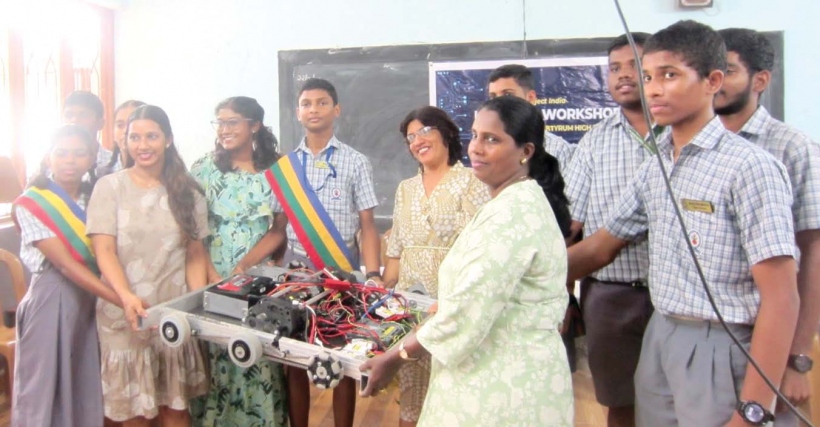
Dolcy D’Cruz
After learning about the interest students at the Regina Martyrum High School had in robotics, American student, Daffny Cardoso, from Townsend Harris High School, New York, took it upon herself to relay her knowledge on the topic to students at the school. Daughter of Hilario Cardoso and Sophia D’Silva, Daffny finds joy every time she visits Goa.
“I travel to Goa as often as I can, every 2-3 years. I love the vivid and vibrant community in Goa. Everyone is supportive and there for each other; the children are lively and are always ready to learn and take on new challenges. The setting in Goa is extremely different from the fast-paced urban life I live in New York City, so I love the change of environment when I come to Goa and all the greenery and landscape that I can take in. My father was born and raised in Colleavaddo, Assolna. He, himself, attended the Regina Martyrum High School when he was younger. Throughout the years, Assolna has always served to be my second home away from America. The community here has truly been a supporting pillar of my life, always providing their assistance to my family when needed,” says Daffny.
She recently worked on a project, Project India 2.0, at the Regina Martyrum High School in Assolna. She taught 12 students from Classes 6-8 and ultimately guided them when they built the drivetrain robot. The robot performed the functions of moving forward, backward and turning. Daffny, with the help of her high school’s robotics team, the Steel Hawks, designed a 2 week long curriculum, under the title Project India 2.0, aimed at teaching the students mechanical engineering, electrical engineering and programming through building a drivetrain robot.
The 16-year-old was born and raised in New York, USA. She is currently in Class 12 standard where she is a part of the Steel Hawks Robotics Team, an academic team which builds robots and presents them at First Robotics competitions. During the robotics competitions, various robots compete against each other in tasks such as climbing monkey bars, placing cones on nodes, and many others, depending on the year’s game theme. “During the months of January to April, we prototype and build various mechanisms for our robot that we believe will best perform the tasks at competition. I took various engineering classes in my high school including Intro to Computer Aided Design and Principles of Engineering. In the future, I plan on majoring in and pursuing a career in mechanical engineering,” she explains.
Robotics is an ever growing field. There will always be many opportunities present in this field. Robotics being introduced to children sparks their interest and shows them the possibilities of the field. It requires so much critical thinking, and one can never go wrong with utilizing their brain to assist in making a robot move. “It amazes me how one line of code can change the entire course of the robot and how a few wires can power an entire robot. Robotics makes me think outside of the box, as even if I run into a mistake, there are many outcomes for how I can solve the issue. The field also applies lessons from physics, one of my favorite subjects, simply because it's a science course that uses advanced mathematics,” she adds.
Is robotics a compulsory subject in the academic syllabus in the USA? Daffny replies, “Robotics is not a compulsory subject in America’s academic syllabus, rather it is a field that students explore based on their own interest. My robotics team is an after school academic team that meets on Mondays, Fridays, Saturdays and Sundays. During the weekend, our team meets to learn about robotics, prototype our robot designs and build for our competitions. Robotics has opened many doors of knowledge for me as prior to joining the team, I lacked mechanical engineering experience. Exposure to such a program was beneficial for me as without the team, I would not be introduced to a collaborative and engineering based work place until my further studies, such as in college. In my school robotics team, we, the students, build the entire robot, and teachers only intervene when there is something that they want to teach us. I copied this model during my work with Project India 2.0, as I wanted to ensure that students were leading their entire build process, rather than me. Mistakes came along the way, however, these mistakes were important for the students, as they learned how to use tools and skills to undo their mistakes.”
During the workshop, the students guided by Daffny built the drivetrain robot that uses 6 different wheels to drive forward, backward and in a 360 degree motion. The drivetrain has 2 NEO brushless motors and 6 sparks motor controllers; the robot is powered by a lead acid battery. She chose to teach the students how to build the drivetrain robot as the drivetrain is a mechanism for the robotics that they build in America for her robotics team’s FRC (FIRST Robotics Competitions). Every single robot for these competitions requires a drive train as that is how the robot moves on the game field. Without the drive train, the robot cannot move and therefore serves no function on the game field and in the competition.
In addition to its purpose, building the drivetrain also allowed the students to learn a lot of different skills such as how to use wrenches, Allen keys, bolts, nuts, tensioners, tools, CAN wires, power pole wires and how to work with wheels, the power distribution panel, the roborio, the radio, CAN wires, just to name a few things. The students were finally able to test their mechanical and electrical work through running the code on their laptop and moving the robot with a joystick.
Speaking about her experience with the students, she says, “My experience with the students was amazing. The students communicated with me when they had difficulties and collaborated to teach each other different skills. The students were able to build the robot entirely on their own. From adding tensioners to the chains to connecting the final power pole wire, the students did it all and I couldn’t be prouder of them. During our closing day, the students themselves presented to the school committee all that they had learned including the names of the tools and specific tasks they completed to build the robot.
Abner Rodrigues, a student of Regina Martyrum High School says, “This robotics program was completely different from the other programs that I have attended which are usually theory based. These lessons were entirely hands-on.”
Vaillon Cardozo, another student at the school says, “This program was helpful for me as I was able to expand on my own knowledge of robotics while also gaining the ability to share my experience and knowledge to others later on.”
The program had its closing ceremony where the students presented the robot to the school committee. To conclude, Daffny shares her future plans, “I plan on studying mechanical engineering in college and later applying it to a career in aerospace engineering.”
